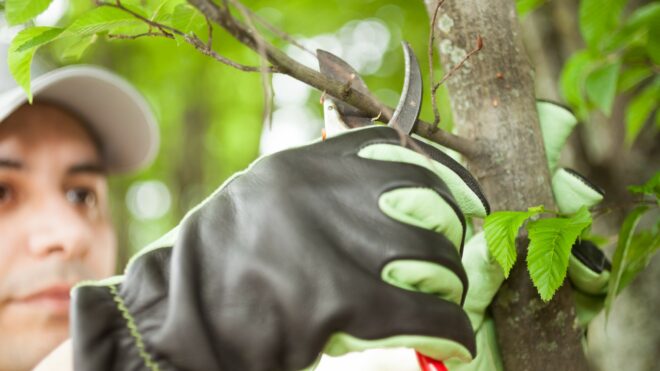Did you know that one tree has a canopy covering almost five acres? It’s a giant banyan located near Kadiri, India, and its name is Thimmamma Marrimanu. Twenty thousand people can stand in its glorious shade.
Townspeople take care to prop up the branches of this magnificent tree, and they carefully guide its roots to the ground. This banyan is estimated to be more than 500 years old.
You might not have a giant banyan in your yard, but your tree’s branches need the same TLC. This article will look at the best time of year to trim trees. Keep reading to learn more about how to keep your trees healthy and thriving.
The Seasonal Cycle of Tree Growth
Trees have a fascinating life cycle. Each year, trees receive temperature and sunlight signals that dictate their growth. As the seasons change, your trees change with them.
Trees in temperate climates follow a similar growth pattern. As daylight hours lengthen and temperatures increase, we see vigorous spring growth. Flowers, new stems, and leaves burst forth from their buds and continue to grow until summer.
During the warmer summer months, your tree begins producing more buds. These buds house the growth you’ll see in the following spring. Summer weather also spurs growth in the tree’s canopy, and a new layer of wood grows on the outside.
As the weather cools and fall arrives, many fruit trees are ready for harvest. Chlorophyll production begins to wane, and the bright green in the leaves fades. Beautiful orange and yellow colors appear before the leaves fall for the year.
When the colder months arrive, most trees become dormant. Growing is hard work for trees. By conserving energy in the winter months, your tree is preparing itself for its next phase of spring growth.
The Difference Between Pruning and Trimming
When we look at tree trimming time, it’s essential to know the difference between pruning and trimming.
Tree trimming is often done when branches grow in areas they shouldn’t. When tree branches hang over your house or power lines, it could spell disaster if they fall. Regular trimming protects your property and prevents injury to the tree.
Regular trimming also helps your arborist identify dying branches. If they can’t be saved the branches should be removed before they fall. Tree trimming is also needed if your trees are suffering from an insect infestation.
Pruning can be used to encourage new growth, especially in fruit trees. Fruit trees are more prone to insect problems. Pruning helps remove the infested part of the tree before the insects spread.
In some cases, pruning and trimming are done simultaneously. Trimming the tree keeps the branches out of harm’s way and pruning targets areas that are diseased or need new growth.
Either way, pruning and trimming your trees is a job for professionals. Trimming during the wrong time of the year can be disastrous for your tree.
The Best Time of Year to Trim Trees
In most cases, winter is the best time to trim trees. Your tree is dormant during this season. Dormancy means most of the tree’s nutrients are stored in the trunk and the root system. Winter trimming minimizes nutrient loss.
Another benefit of winter trimming is clearly seeing the tree’s bare branches. Your tree is covered with buds, new leaves, flowers, and fruit during the warmer months. Trimming now means your arborist can get an accurate and complete view of the branch structure.
Your arborist can also see the buds your tree produced last summer and estimate where new growth will occur. This is where a trained eye is critical. Removing budded branches can cause your tree to lose a whole season’s worth of growth.
Additionally, trees have less sap in their branches during the colder months. Sap attracts insects that could harm or even kill your tree.
Trimming during the winter means not as much sap will leak from the wound. Winter also means the sap will attract fewer insects, which can cause a devasting infestation.
Exceptions to the Winter Trimming Rule
For some trees, trimming during other times of the year is more beneficial. For instance, some evergreen trees have a brief period of dormancy during the summer. Many professional arborists use this time to trim evergreens for shape or remove dead branches.
Some flowering trees, such as redbuds, also need trimming during the early summer months. Since redbuds bloom before intensive leaf growth, it’s usually safe to trim them after the blooms have faded and dropped.
Redbuds also need regular trimming during the first few years of growth. This helps them develop a tree shape instead of their natural, bushy appearance.
Flowering shrubs might also need trimming at different times. Shrubs like azaleas and lilacs bloom from the previous year’s growth. Once their flowers fade in the summer, these shrubs benefit from trimming to encourage next year’s growth.
Plants like roses and dogwood bloom from new growth, so a winter trimming schedule is ideal. Trimming roses or dogwood during the spring means you’ll remove the desirable flower buds.
Flowering shrubs also benefit from fertilization at the time of trimming. Your tree care expert can do both at once.
Learn More From the Tree Trimming Experts
Proper care is vital to the health and safety of your trees. Pruning also helps ensure your fruit trees and flowering shrubs produce big blooms and an abundant crop yield.
Talk to your arborist about the best time of year to trim trees. They’ll help you identify your trees’ trimming needs and set up a schedule that will keep your trees happy for years to come.

